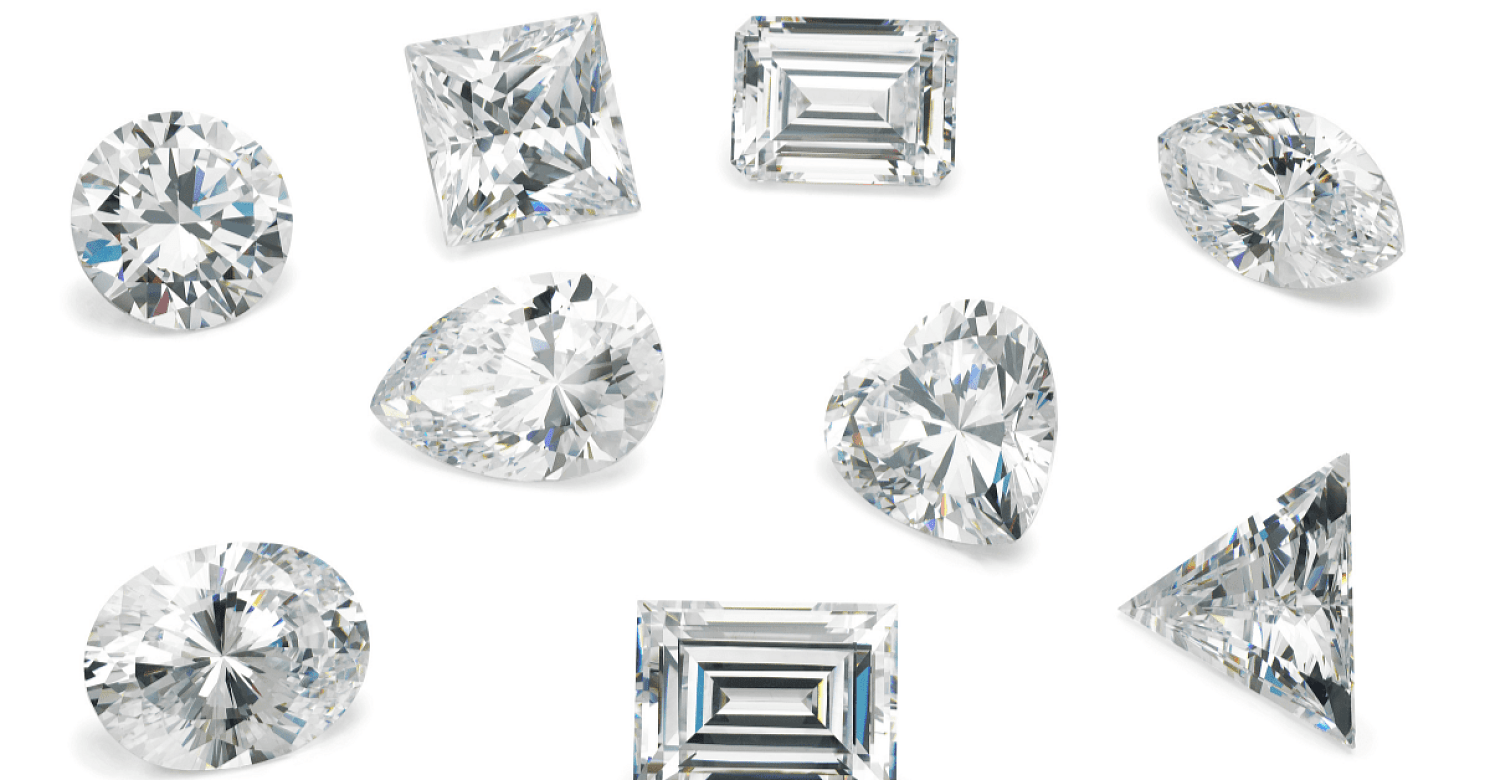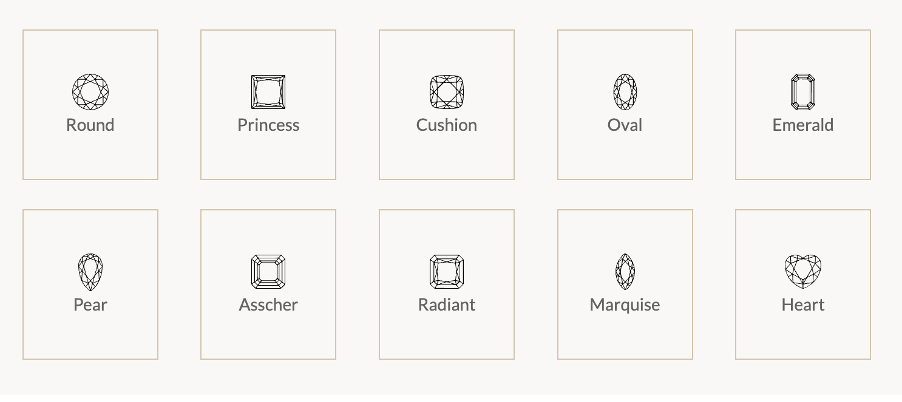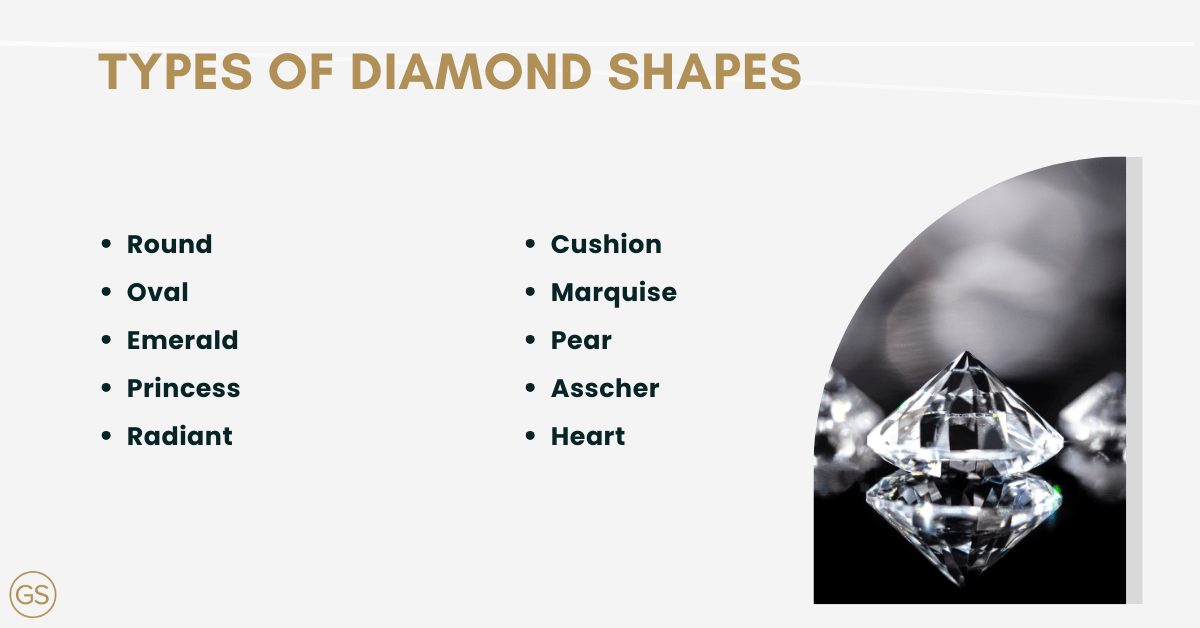
In your search for the ideal diamond, you’ll eventually be faced with the choice of diamond shape for your stone. Different diamond shapes can dynamically change the appearance of any jewellery, and picking the right one can make all the difference in overall design and aesthetics.
Our diamond shapes guide below will help you understand and choose from the various types of diamond shapes on the market.
Different diamond shapes will naturally appeal to evolving buyers’ tastes, market trends, and offer more comprehensvie customisation. The shape of a diamond is a crucial part of buying a diamond, as it can completely change the look of the piece of jewellery it is set in.
Buyers looking for more expressive alternatives to the traditional round diamond shape can now choose from diamond shapes like oval, emerald, princess, radiant, cushion, marquise, pear, asscher, and heart-shaped diamonds.
Some diamond experts and retailers use these two terms interchangeably, but they are actually quite different.
Diamond shapes refer to the unique outline of the stone rather than the quality of its cut. The way a diamond is cut is a whole matter in itself, which you can learn more about in our diamond cut grade guide.
To put it simply, the diamond cut will have more of an impact on the stone’s brilliance and shine compared to the diamond shape, which affect the stone’s overall aesthetic and silhouette. Choosing the shape of your diamond and the quality of its cut are two separate decisions.

Each diamond shape changes the way the stone reflects light, changing how its brilliance is presented and seen by the naked eye. Here are the different shapes that diamonds can come in:
The traditional round-shaped diamond is the most recognisable and popular diamond shape in the world. It features a brilliant cut that contains 58 facets that are specially designed to deliver maximum shine and sparkle.
Oval diamonds are an alternative take on round diamonds that still feature a fully rounded edge but with a slight elongation on one axis. This diamond shape can be used to create a bigger, more impressive appearance.
Having the most popular step-cut shape, emerald-shaped diamonds give off a subtle hint of elegance with an unconventional rectangular outline. The centre of the stone is cut to create the illusion of mirrors that highlight its clarity and offer reflective brilliance.
Renowned for their distinctive four-pointed corners, princess-cut diamonds offer a contemporary allure, coupled with a timeless brilliance. These square-shaped gems showcase more than 70 facets, resulting in remarkable fire and scintillation.
A fusion of the sophisticated allure found in the emerald shape and the fiery brilliance of the round cut, the radiant-cut diamond stands as a stylish hybrid. Its chic and angular design, adorned with subtly trimmed corners, presents a distinct and contemporary charm.

Distinguished by their gentle, rounded edges, cushion-cut diamonds set themselves apart from their sharper, square, or rectangular counterparts. This timeless and romantic selection has evolved over centuries, drawing inspiration from the classic old mine-cut.
Characterised by striking pointed ends and a gracefully curved middle, marquise-shaped diamonds look like sharped ovals. This distinctive elongated shape flows well along the fingers, providing a flattering effect.
Displaying a teardrop shape with a rounded edge tapering to a point at the opposite end, pear-shaped diamonds offer a unique silhouette. Similar to an oval-cut, this elongated shape provides an accent to the fingers, highlighting the distinct sparkle of the stone.
In a manner reminiscent of the emerald-cut, asscher-shaped diamonds showcase the dazzling brilliance characteristic of a step-cut gem. Possessing a square shape with trimmed corners, these diamonds are comfortable in both modern settings and vintage styles.
Symbolic of romance, heart-shaped diamonds gleam with two perfectly symmetrical halves. This meaningful crafted shape has precise symmetry, allowing the diamond's sparkle to take centre stage.
The length-to-width ratio of a diamond determines how symmetrical it is. Some diamond shapes will naturally look better with more symmetry, while others depend on higher ratios to maintain their distinctive shape.
 Ratio.png)
Assuming the diamond carat is kept consistent across all diamond shapes, the biggest-looking diamonds will be those that have an elongated shape, such as the oval, marquise, and pear diamonds. However, these elongated diamond shapes can sometimes include the presence of a diamond bowtie — a dark, bowtie-shaped shadow that appears across the centre of the diamond when viewed face-up. This effect is caused by the interaction of light with the diamond's facets and is a result of misalignment or uneven distribution of light.
So, size isn’t everything, as there are pros and cons for every diamond shape. Our advice is to choose a diamond that complements your (or your loved one’s) personal style. A well-set and thoughtfully designed diamond engagement ring or jewellery piece will look more impressive than one that simply sports a big stone.
Round-diamonds are by far the most valued type of diamond shape, making them the most expensive diamonds based on shape alone. Other diamond shapes from princess-cuts to emeralds can vary greatly in price based on the current fashion trends and shape popularity.
Timeless shapes like round-diamonds and marquise-diamonds will typically fetch consistently high prices due to their perceived value and versatility to match most types of settings.
Finding the right diamond shape is a journey that will require buyers to carefully evaluate how each shape matches their desired style and jewellery piece. For some, trying on these different diamond shapes in person is the best way to see their effect and brilliance. Feel free to rely on this guide when selecting the best diamond shape to create the perfect ring or jewellery gift with GS Diamonds.